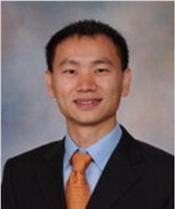Program Information
Photon Counting Detectors and Their Applications in Medical Imaging
T Schmidt1*, S Leng2*, S Molloi3*, K Li4*, (1) Marquette University, Milwaukee, WI, (2) Mayo Clinic, Rochester, MN, (3) University of California, Irvine, CA, (4) University of Wisconsin-Madison, Madison, WI
Presentations
1:45 PM : Principles, Pitfalls and Progress in Photon-Counting-Detector Technology - T Schmidt, Presenting Author2:15 PM : Photon-counting-detector CT: Technical implementations and clinical applications - S Leng, Presenting Author
2:45 PM : Photon-counting detectors in mammographic imaging - S Molloi, Presenting Author
3:15 PM : Phase-contrast imaging of the breast with photon-counting detectors - K Li, Presenting Author
TU-FG-601-0 (Tuesday, August 1, 2017) 1:45 PM - 3:45 PM Room: 601
Photon-counting-detector (PCD) technology continues to be an active area of research in the x-ray imaging community. Different from conventional energy integrating detectors (EIDs), which operate in an energy integrating mode and measure the integrated charge generated by all measured photons, PCDs measure each individual photon and its associated energy. Benefits of a PCD compared to an EID include reduced or fully eliminated electronic noise, improved contrast to noise ratio (CNR) for higher Z materials, and improved dose efficiency. More importantly, the energy discrimination nature of the PCD enables temporally and spatially coherent multi-energy imaging, which may result in novel clinical applications. However, there are challenges associated with this technology, especially with high photon flux associated with x-ray imaging, and non-ideal detector properties such as charge sharing and k escape. Recent advances in detector materials, electronics, modeling/correction algorithms, and imaging techniques have made it feasible to perform in vivo patient imaging with PCD technology in breast imaging and computed tomography (CT). This symposium will describe the current status, challenges and opportunities offered by this technology, as well as possible future directions. Current and potential clinical applications will be discussed, particularly new applications that can only be performed using PCDs.
Learning Objectives:
1. To understand the working principles of photon-counting-detector technology and recognize the differences between photon counting detectors and energy integrating detectors
2. To understand the benefits of PCD in x-ray computed tomography, conventional mammographic applications, and phase contrast breast imaging
3. To recognize the challenges of PCD technology, and actions being taken to address such challenges
4. To learn about potential clinical applications of PCD technology in medical x-ray imaging
Funding Support, Disclosures, and Conflict of Interest: CHM - Grant recipient, Siemens Healthcare
Handouts
- 127-35336-418554-126925-75024319.pdf (T Schmidt)
- 127-35338-418554-126687.pdf (S Molloi)
Contact Email:







